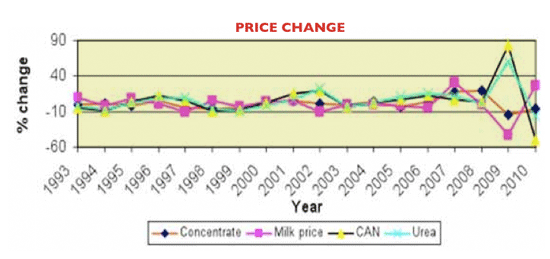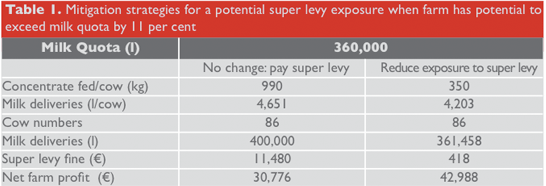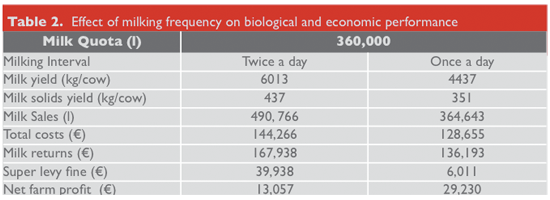



Irish Dairy: Planning For 2015
Dairy producers need to develop low cost production system based on grazed grass in the future so as to ensure the financial viability of the dairy business in a market environment where there is an increased likelihood of input and output price volatility, say Padraig French and Laurence Shalloo from Teagasc.Summary
The profitability of the whole dairy industry (farmers and processors) will be higher by focusing mainly on a seasonal supply pattern of milk based on spring calving systems of production.
A detailed transition plan is now needed on dairy farms so as to best position dairy enterprises to expand profitably post milk quotas. Priority areas for on farm investment between now and 2015 are:
- breeding high ebI replacements.
Identifying and reseeding low performing pastures. - Development of efficient grazing infrastructures.
- Developing labour efficient farmyard infrastructure.
- Improving herd health status.
- Developing skills in grazing management and financial planning.
Introduction
EU milk policy is due to change radically in 2015 with the abolition of milk quotas, which have put major constraints on the industry for the past 30 years. These changes provide a unique opportunity for Irish farmers to grow their business. A ‘freer’ market environment however will be associated with more price volatility. Farmers will now need to grow their business profitably in an environment where the price of milk as well as that of inputs can fluctuate widely. In the period up to 2015, farmers must avoid exposing the farm business to substantial super levy fines. The time frame (~3.5 years) for farmers generally to adapt to this change is relatively short.
Risk and Risk Management
There is a certain amount of uncertainty in any business environment. This uncertainty can provide both opportunities and threats. Risk can be either positive or negative. The important question is how much is the business “at risk”, or how vulnerable is the business to external factors such as weather, price change, etc? The impact of some of these external factors can become more pronounced in the growth phase of the business.
Typically, when farms are in an expansion phase cash flow can become a major constraint and the level of borrowing also generally increases. It is anticipated that milk price fluctuation will pose the greatest risk to the dairy business in the future. However, there are also other significant risks such as the price of feed, fertiliser and fuel, as well as interest rates. Other factors such as weather and animal disease (BVD, IBR, Johnes, etc.) also pose risks. There may be other risks that are relevant depending on circumstance and location.
Figure 1 shows the volatility in prices of milk, concentrate and fertiliser over the period 1993 to 2010 (base year is 1991). It is evident that the volatility in price of both inputs and outputs has become much more pronounced since 2007. Farmers can best adapt to adverse price fluctuations by focusing on reducing the cost of production on their farms. There is evidence for this strategy globally where the lowest cost production systems are observed in the regions where price fluctuation is largest (e.g. New Zealand).
For the business to survive price volatility, Irish dairy farmers will need to focus on developing low cost production systems. This will reduce the exposure to adverse price volatility for inputs and outputs. This strategy also ensures that while the business may not make substantial profit when price drops, it is much more likely to remain viable. A risk management plan should now be an integral part of any expansion plan on dairy farms. The plan should be stress tested against the effect of a number risks which could occur concurrently as was observed in 2009 (weather, milk and fertilizer prices).
Figure 1. Volatility in key input and output prices between 1993 and 2010

Dairy ExpansIon and Seasonality
Expansion in national milk output (post milk quotas) will present major new challenges for the processing and marketing sectors. The potential for growth at farm level is only possible if the additional production can be sold profitably into existing and new markets. Expansion in milk production puts a new focus on the seasonality of production. The focus on this issue is important now as current processing facilities nationally are nearly at full capacity at peak supply.
An increase in output with the current grass based system of production will increase the requirement for additional processing facilities. a recent study at Moorepark investigated the total industry costs (farm and processing sectors) associated with seasonal milk production compared with a relatively uniform supply pattern of milk. Two milk supply profiles were evaluated using farm (inside the farm gate) and processing sector models. In the baseline scenario the mean calving date was 14 February. This was compared to a scenario where 50 per cent of the national herd had a mean calving date of 14 February and 50 per cent had a mean calving date of 1 October.
This resulted in the peak to trough ratio reducing from 5.5 to one to just over two to one (June to January). Investment assumptions around processing capacity for the seasonal supply curve were depreciated over a 15 year period and financed at five per cent interest. The average product prices between 2008 and 2010 were assumed in the analysis.
At farm level, profitability was reduced by €115 million in the split spring/autumn calving scenario when compared to 100 per cent spring calving system. There was a gain at processor level of €49 million for a milk output of just over five billion litres of milk (national supply) in the split scenario. This modelling analysis shows that there is a significant net advantage associated with the seasonal milk supply model.
It strongly suggests that any expansion in the national herd should follow a spring calving system of production. Dairy farmers will now need clear signals for the processing sector as to the market potential and processing requirements for the growth in the sector outlined in Food Harvest 2020. There is also the question of who is going to pay for the additional processing facilities required.
Milk Quota Management Up To 2015
Individual milk producers have supplied milk well in excess of their milk quota in 2010/11. Farmers contemplating exceeding their milk quota in the current quota year and in the period up to 2015 need to be aware that there is now a real risk of super levy penalties as national herd size increases. Urgent attention to quota management is now required. Depending on the level of risk, a number of options can be considered. The quota management plan will also need to consider how the farm can be best positioned to grow post milk quotas. Options to consider include:
- Reduce or omit supplementary concentrate feeding
- Feed more milk to calves
- Purchasing milk quota
- Reduce milking frequency for part or all of the year
- Reduce lactation length
- Reduce herd size
The choice and number of options chosen will depend on the farm. The overall costs of production, and therefore profitability of the farm will be driver of the plan being implemented. For example, the purchase of milk quota will be a viable option for some farmers depending on costs of production, stage of expansion and location (milk quota exchange), while for others contracting the herd size maybe the only viable alternative where the farm is being operated at high cost, at high stocking rates and where there is a large amount of supplementary feed used. Milk quota management strategies for three different farm case scenarios, where the farm has the potential to produce 11 per cent, 30 per cent and 50 per cent over their respective milk quotas, are described.
Farm 11 Per Cent Over Quota
In this first scenario, a milk producer has the potential on their farm to produce 11 per cent over their milk quota in the 2011/12 milk quota year. This producer has to decide whether to exceed the quota available in a similar way to 2010/11 milk quota year, or whether they should take action on their farm to reduce the exposure to super levy fines. In Table 1 two options are presented.
In option one, the producer does not change their management decisions and ultimately incurs the super levy fine, while in the second option the producer takes action to reduce the exposure to super levy fine. In this analysis the farm has the potential to produce 400,000 litres with an actual milk quota of 360,000 litres. Reducing concentrate supplementation from 990kg of concentrate per cow to 350 kg (still allowing for 120 days of supplementation of up to three kg/ day) of concentrate per cow results in a milk sales reduction of approximately 10 per cent. This results in a small super levy fine of €418.
If milk super levy applies to excess milk produced it will amount to €11,480. The overall farm profitability of the farm is increased by 40 per cent by following the strategy of reducing the level of concentrate feeding. In the event of no super levy applying and based on a milk price of 32 c/l, concentrate cost of €260/tonne and a response to concentrate of 0.7 litres milk/kg of concentrate, there would still be a small reduction in profitability from the high level of concentrate feeding.

Farm 30 Per Cent Over Milk Quota
In the second scenario, the farm has the potential to produce 30 per cent over the actual milk quota available in the 2011/12. Similar to the first scenario, the supplementary feed levels should be reduced and this will reduce milk output by approximately 10 per cent. The next option available is to milk cows once a day for part or all of the lactation.
Table 2 presents a comparison of ‘Once a Day’ with ‘Twice a Day’ milking modelled from research conducted at Moorepark over a two year period. Cows were milked once or twice daily for the entire lactation. In this analysis, the reference milk concentration for the fat adjusted milk deliveries is 3.80 per cent. Full labour costs are included in the analysis with 25 per cent less labour in the once a day system (at a rate of €12.44/hour). The results presented show that if the herd was milked for the entire lactation twice a day the farm would have incurred a super levy fine of €39,938.
Milking the herd once a day for the full lactation reduced milk output by 26 per cent. as a consequence, the potential super levy fine is reduced to €6,011. The profitability was €16,173 higher when the cows were milked once a day. There may be a requirement to sell cows with cell counts greater than 250,000 before embarking on once a day milking. If a ‘concentrate effect’ is also included in this scenario the super levy fine would be removed entirely.
Farm 50 Per Cent Over Milk Quota
In the third scenario, the farm has the potential to produce 50 per cent over the actual milk quota available in the 2011/12. It is not possible to reduce milk output enough in this scenario to fully insulate against a super levy fine without selling some stock from the farm. Reducing concentrate feed (to the extent described) and milking cows once a day will have the effect of reducing milk output by approximately 35 per cent.
Mature cows produce 25 per cent more milk than heifers, have the lowest EBI, have a higher probability of having a higher cell counts etc. A 10 per cent reduction in mature cows will reduce milk output by 11.5 per cent which, when coupled with the reduction in concentrate feed and a reduction in milking frequency, has the potential to reduce milk output by approximately 45 per cent.

Key Components Of Profitable Expansion
Rapid dairy expansion will be possible post 2015 and individual dairy farmers should only expand their dairy enterprises if it increases farm profitability. The short to medium term outlook for a relatively high milk price is positive and it is likely that technically efficient farmers will generate significant amounts of surplus cash in their business over the next three years prior to quota removal. Farmers who are considering a long term future in dairying and expanding post quotas should use this time to prepare their businesses for the post quota era. The following aspects of the dairy farm business should be priority areas for investment between now and 2015.
Breed High Genetic Merit Replacements
Cows that are bred in 2012 and subsequent calves born in 2013 will themselves be calving down in a post quota environment (2015). While there is likely to be adequate dairy stock on farms from now until 2014 to fill the national quota, it is likely that in 2015 there will be an insufficient number of young high genetic merit dairy stock for both the expanding dairy farms and the new dairy conversions. Plans should be put in place to increase numbers of high ebI breeding females on farm between now and 2015.
Identify And Reseed Low Performing Pastures
Nationally, dairy farmers are utilizing 6.4 t DM/ha annually. There is significant potential to increase this with a realistic target of 11-12 t DM/ha achievable on farm. This will only be increased through the implementation of a plan that will result in increased herbage production, increased stocking rates and reduced concentrate supplementation. Farms should be monitored for overall and seasonal herbage production and individual paddock performance investigated. soil fertility and reseeding programs should be implemented on every farm to increase herbage production and utilisation. The stocking rate and supplementation levels on the farm should be based on the herbage supply versus demand relationship.
Develop Grazing Infrastructure
The single biggest biological factor influencing the profitability of Irish dairy farms is the amount of grass utilised by the dairy herd. As well as growing large amounts of grass, a key requirement for profitable dairy farms will be the utilisation that grass over a long grazing season. This will require good grazing infrastructure such as farm roadways and suitable paddock and water systems.
Develop Grazing Infrastructure
The single biggest biological factor influencing the profitability of Irish dairy farms is the amount of grass utilised by the dairy herd. As well as growing large amounts of grass, a key requirement for profitable dairy farms will be the utilisation that grass over a long grazing season. This will require good grazing infrastructure such as farm roadways and suitable paddock and water systems.
Develop a Labour Efficient Infrastructure
Most capital investments on dairy farms have a much longer life span than the milk quotas are projected to have. One of the factors that will limit the ability of farmers to manage larger herds will be inadequate time available for management because too much time is taken in daily work routines and in particular milking. Any capital investment on dairy farms undertaken between now and 2015 should be considered relative to the type and scale of farm business that will be operated post 2015. Investments should be judged based on their impact on farm output, labour input and total input costs in a non milk quota scenario. Investments that are likely to pay dividends post quota abolition are those that reduce time spent milking such as larger milking parlours and facilities that improve cow low at milking.
Improve Herd Health Status
The health status of the dairy herd will determine whether any or all of the production and economic targets are met. Maintaining a healthy herd is one of the largest prerequisites to developing and maintaining a profitable dairy herd. The loss of livestock through culling or death has a substantial effect on the potential of the business to expand. The period between now and 2015 allows an opportunity to increase the health status of the dairy herd by developing a herd plan that includes getting to know the health status of your herd, implementing a good biosecurity protocol and preventing disease spread through targeted vaccination.
Develop Skills in Grazing Management and Financial Planning
The biggest factor determining the success of any dairy farm business is the ability of the farm manager to identify, quantify and deliver on the goals of the business. For seasonal grass based systems, the skills that will be required most in the post-quota era are grazing management and financial planning. These are skills that take time to develop and should be a priority for all dairy farmers/managers who intend to run successful dairy businesses post quotas.
Conclusions
The Irish dairy industry has now entered a period of transition as the effects of milk quota, which has limited the potential of the dairy industry for 30 years, are being removed. Expansion should only be planned if it is going to result in increased farm profitability and improved livelihoods. The significant net advantage associated with seasonality will ensure that spring calving grass based systems will be the most sustainable model into the future.
However, there is likely to be more pronounced price volatility for inputs and outputs, and this is likely to be a key feature of the economic environment into the future. Milk quota management plans should be developed on all farms which will allow the farms to expand while minimising the exposure to super levy fines. Farmers should prioritise surplus cash over the next three years for investment in technologies that will increase productivity from grass based milk production systems.



